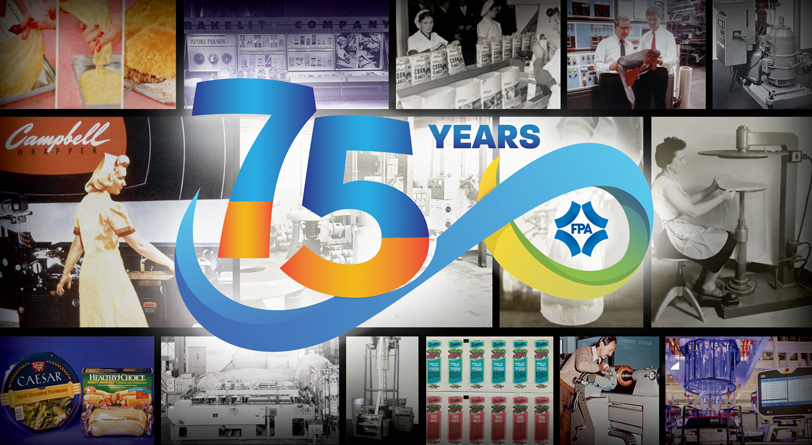As part of its 75th anniversary celebration, the Flexible Packaging Association (FPA) has produced videos, a storybook, and an extensive timeline that highlight the association’s key milestones over the years.
The videos, available on YouTube, feature testimonials from top executives in the flexible packaging industry, as well as former association and FPA board leaders.
“An industry association wouldn’t endure for 75 years if it didn’t deliver meaningful benefits, says Kathy Bolhous, a former FPA board chair and chair and CEO of Charter Next Generation.
Alison Keane, who served as FPA president and CEO from 2016 until the summer of 2024, says in the video that one of her missions was to increase advocacy for flexible packaging. In recent years, states have been moving to adopt extended producer responsibility laws that require packaging companies to pay for the ultimate end use of their products. The goal has been to make sure the interests of member companies are represented when action is taken.
FPA, which is based in Annapolis, Maryland, also focuses on industry growth, professional development, and networking opportunities. All of that comes at a time when plastic packaging, in general, has to demonstrate why it is a better alternative than other packaging forms. “You need a good, consistent industry voice that keeps the facts clear,” says Jimmy Love III, chair and CEO of Printpack, which has been an FPA member for about 65 years.
Proud History
Another video highlights some of the differences between 1950 and now:
- In 1950, the U.S. population was 151.3 million, increasing by 125.4% to 341 million today, according to the video.
- Along the way, FPA’s membership grew from approximately 50 members to its current total of just over 200 members.
- Sales volumes for flexible packaging were $150 million in 1951, which compares with $42.9 billion today.
- FPA has had only seven leaders in its 75-year history, including the hiring of Dan Felton, the current FPA president and CEO, who replaced Keane in 2024.
FPA has also produced an 84-page storybook that showcases the organization’s history in an elaborate, illustrated timeline. The timeline runs through FPA history by each decade, starting with the 1950s.
“Even the most knowledgeable observer struggles to grasp how far our nation has come since July 19, 1950, when the National Flexible Packaging Association (NFPA) was founded,” according to the start of the timeline. “Harry Truman was president, and the U.S. was engaged in the Korean War.”
Recognizing the need for improved communication and cooperation between packaging manufacturers and suppliers, NFPA was incorporated in Chicago by Albert A. Meister, who was the founder and the first chair of Bagcraft Corporation; R. E. Pentz of Oneida Paper Products; and R. E. Hanson of Milprint.
Hanson was named NFPA’s first president.
Through the Decades
In 1950, companies faced challenges securing raw materials and accessing civilian markets, according to the timeline.
“One of the greatest challenges during the association’s early years was to be effective without violating the government’s antitrust laws,” according to the timeline. “The issue, common to all industrial organizations, concerned NFPA as it matured.”
The timeline goes on to tout industry innovations as well as milestones in FPA’s history. In the 1960s, for example, “individually quick frozen vegetables were introduced in flexible packages.”
Earth Day was founded in 1970, marking a new regulatory era for industry, according to Glenn Braswell, FPA president from 1986 to 1999.
“This landmark event,” Braswell is quoted as saying on the timeline, “set up a whole new political, social, and legal system that required American businesses to accept greater environmental responsibility for their products and manufacturing operations.”
The 1980s were marked by significant technological advancements, followed by an information revolution in the 1990s that included the advent of email.
“The Association not only offered comprehensive and complex information about technology, industry statistics, trends, laws, and regulations to its members but also delivered information to legislators, regulators, educators, and the general public,” the timeline says.
The dawn of the new century brought new challenges, including concerns about plastic pollution and the quest for sustainable packaging alternatives.
“The push for post-consumer recycled content in packaging became widespread, and biodegradable and compostable materials such as polylactic acid, polyhydroxyalkanoate, and paper-based alternatives gained traction, especially in food packaging,” the timeline says about the 2010s.
And, of course, the 2020s began with the COVID-19 pandemic, which led to even more innovations, particularly in e-commerce. “The flexible packaging sector not only united but also emerged stronger and more innovative after the pandemic,” the timeline notes. “The crisis led to faster advancements in sustainable packaging, smart technologies, and supply chain resilience, ensuring the industry remains adaptable to future global challenges.”
Editor’s note: The photos used in the collage are courtesy of FPA’s 75th Anniversary storybook and participating members, www.fpa75.com.
Thomas A. Barstow is senior editor of FlexPack VOICE®.
